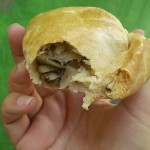
No, no, no—not those. I know what you’re thinking.
I’m talking about one of the food staples of the iron ore workers in the Upper Peninsula of Michigan—the pasty. Think in terms of a giant Italian Stromboli. A flaky crust (usually a pie crust) enveloping meat, diced potatoes, carrots, onions, or anything Mom or Dad could think of. It was (and is) a hearty baked meal—one to satisfy the hunger of very hard working people.
Do you know why the edges of the pasty are so thick? It’s because the iron ore workers didn’t wash their hands and so they picked up the pasty by the outer crust and then discarded the crust after eating the main section of the pasty.
Pasties were eaten in the Middle Ages as part of the supper. Instead of beef or pork, the meat would usually be roast boar, pigeon, or wild game that was hunted. The pasty originated in England, and in particular, Cornwall where miners ate them for lunch. By the mid-1800s, the pasty had been introduced to the diet of the Upper Peninsula miners.
Today, we raise turkeys, pigs, cattle, and other animals for our consumption. During the Middle Ages, other animals were considered a delicacy. Besides the boar, deer, and other hunted animals, the nobility would gather up, fatten up, and glutton up on the following: Read More Pasties and Medieval Suppers

